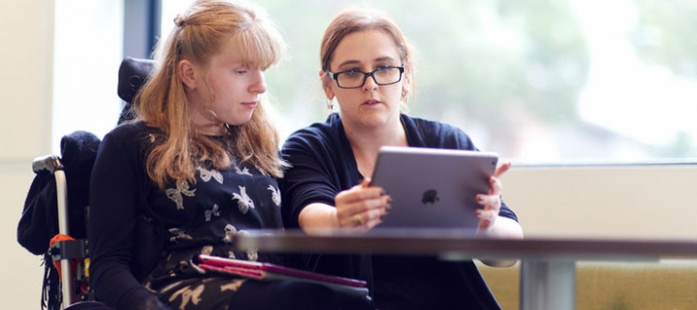By Yvonne Tevis.
May 17, 2018, is Global Accessibility Awareness Day or “GAAD,” as they say.
What does that mean? Well, walk for a minute in someone else’s shoes – particularly someone who is disabled and has to use assistive technology to surf the web, watch a video, or complete an online form.
When you do that, you’ll understand why IT needs to be designed to be accessible to the people who use assistive technologies like screen readers.
What is a screen reader?
A screen reader is software used by blind or visually impaired people. It reads the content of a website or application out loud. The caveat, of course, is that the site must be coded so the screen reader can follow content in a logical order, tell the user what the links actually go to, and generally have things makes sense. For a demo, watch Web Accessibility Evangelist Lucy Greco at UC Berkeley using a screen reader.
What’s it like to use assistive technology?
Here are a few things you can try so that you better understand what disabled people face when navigating the web – and what developers and designers need to keep in mind to make our IT environment accessible. These examples were provided by the GAAD website:
Go mouseless for an hour
If someone has motor control or other disabilities (including vision impairments) that prevent them from using a mouse, they may use the keyboard to navigate a site.
To see what that can be like, disable your mouse or touchpad and only use your keyboard (tab/shift tab, arrow keys, enter key, and spacebar) to navigate and interact with websites and applications.
Enlarge your fonts
If someone has low vision, they may need to be able to enlarge text and other content.
To see what that can be like, use your browser and resize the text to 200 percent. Does it work? Is there any loss of content or functionality? Did all elements resize, including all widgets?
Check for sufficient color contrast
If someone has vision impairments or is color blind, websites have to have sufficient color contrast for them to see the content.
You can download a color contrast analyzer and find out how your page(s) stack up.
Check the order of elements
If someone uses a screen reader, it’s essential that the page be designed so that the content will be read out loud in the correct order. To see what this can be like, disable the page’s stylesheets and compare the order of elements before and after.
Do you want the full experience?
Well, launch a free screen reader and then unplug your mouse and turn off the monitor. Then spend awhile on the sites you like, using only the keyboard (tab/shift tab, arrow keys, enter and spacebar) to get around.
Learn more
Many people across the UC system are dedicated to helping create an accessible IT environment at UC. On the UC electronic accessibility website, you can find all kinds of information – everything from resources for web developers, UC’s IT Accessibility Policy, guidelines for buying accessible products, and the experts at each UC location who can help you out.
So go ahead and be GAAD, unplug your mouse…
 Yvonne Tevis is editor of the UC IT Blog and chief of staff, Information Technology Services, UCOP.
Yvonne Tevis is editor of the UC IT Blog and chief of staff, Information Technology Services, UCOP.
Photo courtesy of Creative Commons: Sophie from Treloar College whose ‘Voice It’ app is an entry in the 2015 Summer of Student Innovation ©Jisc and Matt Lincoln CC BY-NC-ND







